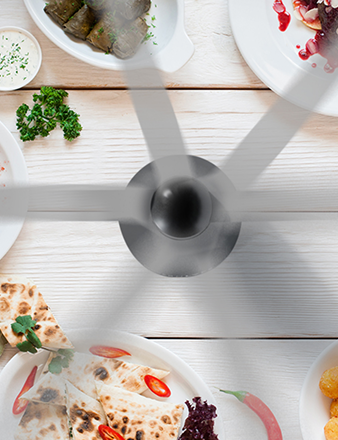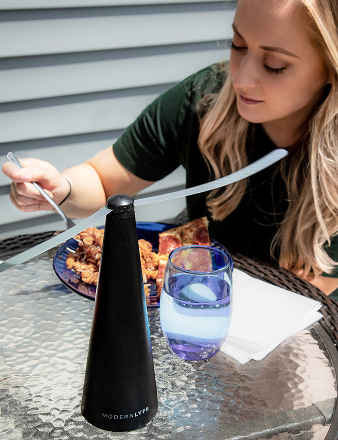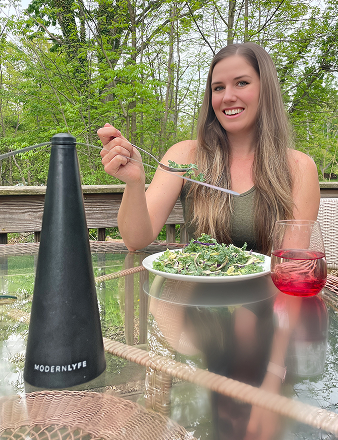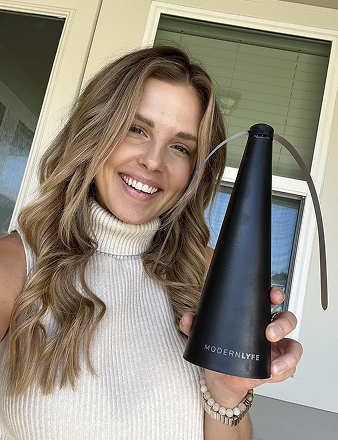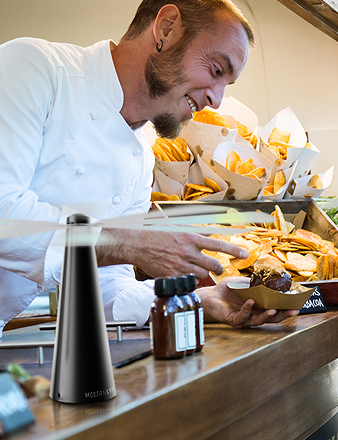A 10x10 screened canopy is your ticket to an instant, bug-free outdoor room. It’s a portable, 100-square-foot sanctuary from insects, sun, and light rain, combining the convenience of a pop-up canopy with the comfort of a screened-in porch.
This makes it the perfect upgrade for backyard dinners, camping trips, or any outdoor event where you want to relax without pests.
Your Instant Bug-Free Outdoor Room
Imagine a perfect summer evening without swatting mosquitoes or guarding your food from flies. That's the simple promise of a 10x10 screened canopy. It's a highly effective solution that turns any patch of grass or patio into a comfortable, protected space in minutes.
A standard canopy offers shade. A screened canopy changes the game entirely, creating a real barrier against bugs. It’s less like camping gear and more like a portable extension of your home.
More Than Just a Bug Shield
While insect control is the main draw, these canopies deliver three key benefits for anyone who loves being outside. They tackle the most common issues that can ruin an outdoor event.
Here’s what you get:
- Complete Insect Protection: The fine mesh walls are your best defense against everything from buzzing flies to tiny gnats and mosquitoes. Finally, a peaceful place to eat and relax.
- Reliable Sun Shelter: The canopy roof provides essential shade. Most are coated with a UV-protectant layer to help shield your family from harmful rays.
- Defense Against Light Rain: A water-resistant top means a sudden, light shower won't send everyone running for cover. It’s just enough protection to keep the event going.
The Perfect Blend of Space and Portability
The 10x10 foot size is an industry standard for a reason. It hits the sweet spot, offering 100 square feet of usable space—enough for a picnic table and chairs—while remaining easy for one or two people to set up.
This balance of generous space and easy transport makes the 10x10 screened canopy a modern outdoor essential. It lets you create a controlled, bug-free zone anywhere. This is a game-changer for keeping food safe during barbecues. For more tips on this, learn how to effectively use a fly cover for food.
How to Choose the Right Screened Canopy
Picking the right 10 x 10 screened canopy comes down to knowing what to look for. Not all canopies are created equal, and spotting the difference between a durable model and a flimsy one will save you future headaches. Think of it like buying a car—what’s under the hood matters most.
To make a smart choice, focus on three key components: the frame, the mesh, and the fabric top. Getting these right ensures you'll have a reliable shelter for everything from a family BBQ to a weekend craft fair.
This infographic shows when a screened canopy is the perfect tool for the job, protecting you from common outdoor party crashers: bugs, sun, and unexpected rain.
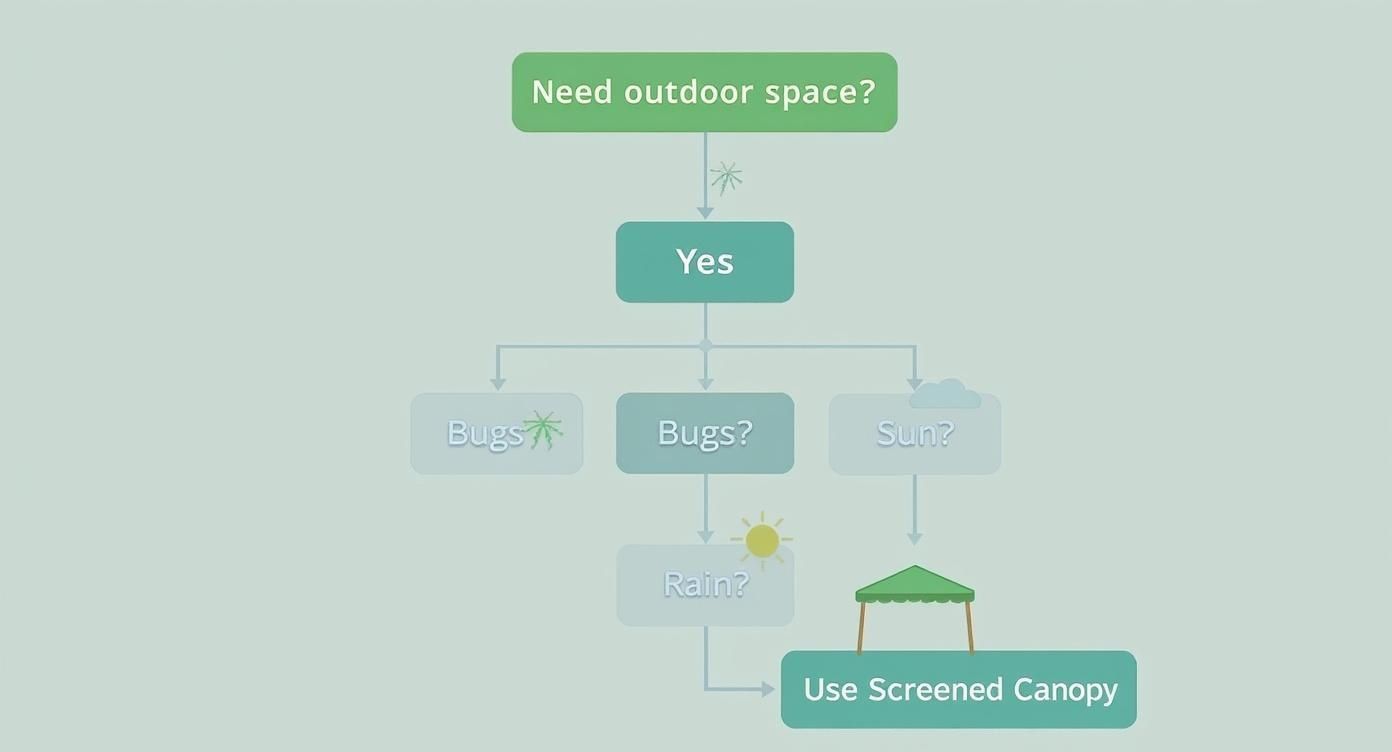
As you can see, the moment you need a defense against insects, sun, and light rain, a screened canopy becomes the most practical solution.
Decoding the Frame Materials
The frame is the skeleton of your canopy. Its material directly impacts weight, sturdiness, and lifespan. The two main options are steel and aluminum.
- Steel Frames: These are heavy-duty workhorses. Steel is incredibly strong, making it the best choice for windy conditions or frequent use. The trade-off is weight; steel frames are heavier, making them harder to transport and set up.
- Aluminum Frames: If portability is your priority, choose aluminum. It's significantly lighter than steel, so carrying it from the car to your spot is easy. While not as tough as steel, a quality aluminum frame offers a great mix of convenience and durability for casual use.
Rule of Thumb: For weekend-long setups or market vendors needing maximum stability, the extra weight of a steel frame is worth it. For day trips and family outings with frequent setup and takedown, an aluminum frame makes life much easier.
To help you decide, here's a quick side-by-side look at the most common features.
Canopy Feature Comparison Guide
This table breaks down the key choices you'll make when selecting a canopy, from frame material to fabric type, helping you pinpoint what's best for your needs.
| Feature | Option A | Option B | Best For |
|---|---|---|---|
| Frame Material | Steel | Aluminum | Steel: Heavy-duty, frequent use, windy areas. Aluminum: Portability, casual use, easy setup. |
| Screen Mesh | Standard Mesh | No-See-Um Mesh | Standard: All-purpose bug protection (mosquitoes, flies). No-See-Um: Areas with gnats or tiny insects. |
| Fabric Denier | 150D - 300D | 420D - 600D | Lower Denier: Light, occasional use. Higher Denier: Durability, frequent use, better tear resistance. |
| Setup Mechanism | Basic Pop-Up | Central Push Hub | Basic: Budget-friendly, requires 2 people. Central Hub: Fast, one-person setup. |
Ultimately, matching these features to your intended use is the key to finding the perfect fit.
Understanding Screen Mesh Types
The screen is the main event, but not all mesh is the same. The tightness of the weave determines which pests get blocked.
Standard Mesh: This is found on most canopies and is great for keeping out common pests like mosquitoes, flies, and bees. For most backyard events, this provides a comfortable, bug-free zone.
No-See-Um Mesh: If you've ever been swarmed by gnats or midges, you need this. "No-see-um" mesh has a much finer weave, creating a barrier against even the tiniest pests. It may slightly reduce airflow, but it provides 100% peace of mind in buggy environments.
Fabric Specifications That Matter
The fabric roof is your first line of defense against sun and rain. Look for these specs to understand the level of protection you're getting.
- Denier (D): This number indicates fabric thickness and toughness. A higher denier, like 420D or 600D, is more durable and tear-resistant than a lower-rated 150D fabric. For regular use, look for 300D or higher.
- UV Protection (UPF Rating): Like sunscreen, canopy fabrics have a UPF (Ultraviolet Protection Factor) rating. A UPF 50+ rating is the industry standard, blocking over 98% of harmful UVA and UVB rays.
- Water Resistance: Most canopies are "water-resistant," not "waterproof." They handle a light shower but may leak in a heavy downpour. Look for tops with sealed seams and a polyurethane (PU) coating for better water protection.
Essential Ease-of-Use and Stability Features
Finally, consider the small features that make a canopy a joy to use.
A pop-up mechanism with a central push-up hub is a game-changer, often allowing one person to set up the entire canopy in minutes. This is a massive time-saver for market vendors. Speaking of which, for stall inspiration, see our guide on outdoor vendor booth ideas.
Stability is non-negotiable. A vented top allows wind to pass through, preventing your canopy from becoming a kite. Always ensure the canopy includes stakes and guylines, and invest in leg weights for setup on hard surfaces like a driveway or patio. Properly anchoring your canopy isn't a suggestion—it's essential for safety.
Nailing a Fast and Secure Setup
Nobody wants to spend an hour wrestling with poles and fabric. The magic of a modern 10 x 10 screened canopy is its pop-up design. With a little practice, you can have it up in minutes.
The process is simple: pick your spot, open the frame, attach the top, and raise the legs. A smooth setup protects your canopy from accidental damage.

The Pre-Setup Checklist
Before you unzip the bag, a minute of planning can save you from common headaches.
- Scout Your Location: Find the most level ground possible. Check for low-hanging branches or power lines that could tear the fabric.
- Check the Wind: If it's already gusty, reconsider your location or have extra weights and heavy-duty stakes ready. Safety first.
- Recruit a Helper: One person can do it, but two people make the job faster, easier, and safer by expanding the frame evenly.
Step-by-Step Pop-Up Assembly
Most pop-up canopies follow the same process. Avoid rushing and forcing parts.
- Partial Frame Expansion: With a partner on opposite sides, grab the outer legs and walk backward slowly until the frame is about halfway open in a diamond shape.
- Attach the Canopy Top: Drape the fabric top over the partially opened frame. Secure the corners with the built-in Velcro straps. It's much easier to do this now than when the legs are fully extended.
- Full Frame Expansion: Continue walking backward until the frame is fully expanded. Listen for the corner sliders to "click" into place, confirming the frame is locked.
- Raise and Lock the Legs: One corner at a time, lift each leg until it clicks into its locked position. Start with two adjacent legs on one side before moving to the other.
The most common mistake is forcing the frame open too quickly. Let the truss bars work. If you feel resistance, stop and check for snags. A smooth, steady pull is better than a hard yank.
Anchoring Your Canopy for Any Surface
An unanchored canopy is a safety hazard. Your anchoring method depends on the surface and is the most critical step for a secure setup.
For more on ensuring your shelter is stable, this guide to heavy duty gazebos offers relevant tips.
- On Grass or Dirt: Use the included stakes. Drive them through the feet of each leg at a 45-degree angle away from the canopy for a stronger hold. For extra security, attach guylines to the top corners and stake them out a few feet away.
- On Pavement or Decks: Use weights. Canopy weight bags are ideal. Fill them with sand or water and strap one tightly to each leg. Aim for at least 25-40 pounds per leg.
- On Sand: Standard stakes won't work. Use special sand stakes or fill weight bags with sand from the beach. Burying the bags a few inches adds even more stability against coastal breezes.
The Takedown and Pack-Up
Packing your 10 x 10 screened canopy correctly is as important as setting it up. A good takedown routine prevents damage and ensures it fits back in the bag.
First, ensure the canopy top is completely dry to avoid mold and mildew. Next, lower the legs and release the corner sliders. Push the frame inward until it’s halfway collapsed, then remove the fabric top. Push the frame completely closed. Fold the top neatly, then slide everything into its storage bag.
Creative Ways to Use Your Canopy
Your 10 x 10 screened canopy is more than just a shelter—it's a blank canvas. This portable space can transform to fit almost any scenario, from a quiet backyard retreat to a bustling event hub.
Think of that 100-square-foot area as a flexible, adaptable room. With a few simple touches, you can quickly set it up for dining, playing, working, or relaxing.

The Ultimate Outdoor Dining Room
One of the most popular uses is creating a bug-free dining area. Host a barbecue where guests can enjoy their food without swatting away flies. A 10 x 10 screened canopy easily fits a dining table and chairs, making any meal more pleasant.
To elevate the experience, add a few accessories:
- Outdoor Rug: A simple rug defines the space and keeps feet clean.
- String Lights: Battery-powered LED lights create a warm glow for evening dinners.
- Table Caddy: An organizer for napkins and utensils keeps the area tidy.
A Safe and Shaded Kids' Play Zone
For parents, a screened canopy is a game-changer. At the park, beach, or in the backyard, it creates a contained, shaded area where kids can play safely, protected from the sun and insects like bees and mosquitoes.
This setup lets children enjoy the fresh air without the usual worries. It’s the perfect spot for toys, coloring books, or even a nap, ensuring they stay comfortable all day.
The Campsite Living Room
When camping, your 10 x 10 screened canopy becomes the heart of the site. Set up chairs, a cooler, and a table to create a comfortable "living room" for everyone to gather, especially in the evening when bugs are most active.
Pro-Tip: Set up your cooking station just outside the screen and bring plates inside to eat. This simple trick keeps your dining area bug-free and elevates the entire camping experience.
This functional space also keeps gear organized and provides a reliable refuge from sun or light rain.
The Professional Vendor Booth
The demand for portable shelters is rising. The North America freestanding canopy market was valued at USD 52.0 million in 2022 and continues to grow, highlighting the value of a 10 x 10 screened canopy for small businesses. You can find more details on this expanding market and its trends.
For a craft fair or farmer's market, a screened canopy creates a professional, inviting booth. The screen walls define your space and protect products from dust and leaves while allowing customers to see your offerings. Add banners and lightweight shelving to create a polished display. For more ideas, check out our guide on essential outdoor entertaining accessories.
Keep Your Canopy Going Strong: Care and Maintenance Tips
Your 10 x 10 screened canopy is a durable piece of gear, but it requires care to last. Think of it like a quality tent—a little attention now prevents major issues later. Proper cleaning, quick repairs, and smart storage are key to maximizing your investment.
Most canopy damage doesn't happen during use but from improper cleaning and storage. A few minutes of post-event care protects fabric coatings, keeps zippers running smoothly, and prevents frame damage.
Routine Cleaning and Staying Ahead of Mildew
Keeping your canopy clean protects the material. Dirt, bird droppings, and tree sap can degrade the fabric's water-resistant and UV-protective coatings.
For basic cleaning, use a soft sponge, mild soap (dish soap works well), and cool water. Avoid harsh detergents, bleach, or chemical cleaners, as they can strip the protective coatings, leaving the fabric vulnerable to sun and rain.
Golden Rule: Never store your canopy unless it is completely dry. Packing it away even slightly damp invites mold and mildew, which can permanently stain and weaken the fabric.
Handling Repairs on the Fly
Small snags in the screen or tears in the roof can happen. Fortunately, these are usually simple fixes if you catch them early. Keep a small repair kit in your canopy's storage bag.
A good DIY repair kit includes:
- A Screen Patch Kit: Peel-and-stick patches make fixing a hole in the mesh a 30-second job.
- Fabric Repair Tape: Products like Tenacious Tape are perfect for patching rips in the canopy top.
- Zip Ties and Duct Tape: These universal problem-solvers can provide a temporary fix for almost anything, from a stubborn leg joint to a broken clip.
Smart Storage for a Long Canopy Life
How you store your canopy between uses is critical. Stashing it in a damp corner of the garage is a recipe for a short lifespan.
Follow these simple storage rules:
- Clean and Dry, Every Time: Air it out completely to ensure all moisture and condensation are gone.
- Pick a Cool, Dry Spot: A garage, dry basement, or shed is ideal. Avoid extreme temperature swings and moisture.
- Store It Standing Up: Whenever possible, store the bagged canopy vertically to prevent heavy items from being stacked on top, which can bend the frame.
Why Outdoor Shelters Are More Popular Than Ever
The boom in products like the 10 x 10 screened canopy reflects a shift in how we value outdoor space. We are turning our backyards and patios into extensions of our living rooms—making them more comfortable, useful, and bug-free.
This push for better outdoor living is fueling market growth. In 2024, the global canopy industry was valued at roughly USD 2.06 billion and is projected to exceed USD 3 billion by 2030. This signals a sustained demand from both families and businesses. You can explore these market projections and their drivers for more details.
The Rise of the Staycation and Backyard Oasis
The "staycation" is here to stay. Many of us are investing in making our homes the ultimate destination for relaxation. A screened canopy fits this trend perfectly, instantly creating a bug-free zone for dinner, reading, or playing.
It's about reclaiming your own space. Think of it as adding a flexible, seasonal room to your house without the cost and hassle of construction. This simple addition can turn a plain lawn into a true backyard escape.
A screened canopy is an investment in better living. It empowers you to maximize your outdoor time, turning an unpredictable space into a reliable comfort zone for family and friends.
Material Innovations Making Shelters Better
Today’s canopies are a world away from the heavy, clumsy shelters of the past. Modern materials have made them lighter, stronger, and easier to handle. Innovations in aluminum alloys create strong yet portable frames, while new polyester fabrics offer excellent UV protection and water resistance without the bulk.
These upgrades are significant. A shelter that once required multiple people to set up can now often be handled by one person. This ease of use is a major reason why the 10 x 10 screened canopy has become a staple for everyone from market vendors to camping families.
To see how much designs have evolved, explore a diverse collection of outdoor shelters. You're not just buying a canopy; you're joining a larger movement toward smarter, more enjoyable outdoor living.
Got Questions? We've Got Answers.
When you get a 10 x 10 screened canopy, a few questions usually come up. Getting them answered is key to using your shelter safely and ensuring it lasts. Here are some of the most common ones.
Knowing the ins and outs of your canopy prepares you for any situation, making every outdoor gathering better.
How Does It Really Stand Up to Wind and Rain?
Think of screened canopies as your go-to for sun and bug protection. They can handle a light, passing shower, but wind is another matter. A canopy's stability in wind depends on the frame quality and, more importantly, how it's secured. Always use the included stakes and guy lines.
For breezy conditions, add a set of leg weights. However, these shelters are not designed for severe weather. If strong winds or a storm is forecast, take it down. It’s better to spend a few minutes packing it away than to risk a damaged canopy.
A canopy is a giant sail. Anchoring it properly is a critical safety step. Never leave it up unattended in questionable weather.
Can I Bring a Heater or Grill Inside?
That's a hard no. Never use any device with an open flame or one that produces carbon monoxide—like a propane heater, charcoal grill, or camp stove—inside or near a screened canopy.
The fabric is not fireproof and can ignite instantly. Additionally, the enclosed space can trap deadly fumes like carbon monoxide. Keep all cooking and heating equipment a safe distance away in a well-ventilated area to prevent fire and health risks.
Is It Actually Possible for One Person to Set It Up?
While one person can technically set up a 10 x 10 screened canopy, it's far easier, faster, and safer with two people, especially with traditional pop-up designs.
A partner helps you open the frame evenly without stressing the joints. If you plan to set it up solo often, look for models advertised as "one-person setup." They typically feature a central hub that you push up, which makes all the difference.
Ready to create your own bug-free zone for relaxing and dining? At MODERN LYFE, we're all about making outdoor moments more enjoyable. Check out our gear for a pest-free experience and start making the most of your backyard.

